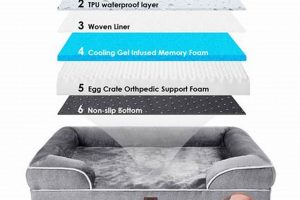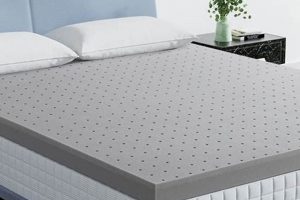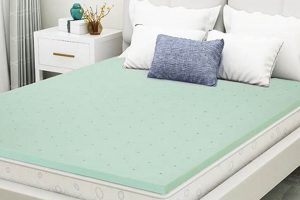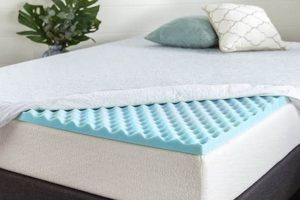Infestations within viscoelastic polyurethane bedding present a particular concern. The dense structure, while offering comfort, can provide harborage for these pests. The material’s composition and construction contribute to an environment where eradication can prove challenging.
Addressing these infestations promptly is critical to prevent widespread propagation and the associated health and economic burdens. Historically, control measures have evolved, from rudimentary physical removal to sophisticated chemical treatments, reflecting an ongoing effort to mitigate this persistent problem. The benefits of effective management extend beyond personal comfort to encompass public health and economic stability.
This article will explore the identification, prevention, and elimination of these infestations within such mattresses. It will delve into various treatment methodologies and offer practical guidance for homeowners and pest management professionals.
Managing Infestations in Viscoelastic Bedding
Effective management requires a proactive approach combining preventative measures and, when necessary, rigorous eradication techniques. Early detection and consistent application of recommended practices are crucial.
Tip 1: Regular Inspection: Conduct routine visual examinations of the mattress, paying close attention to seams, tufts, and crevices. Use a flashlight to aid in the detection of live insects, shed skins, or fecal matter.
Tip 2: Protective Encasements: Utilize certified bed bug-proof mattress encasements. These encasements completely seal the mattress, preventing entry and trapping any existing infestations inside, ultimately leading to their demise due to starvation.
Tip 3: Vacuuming: Regularly vacuum the mattress surface and surrounding areas, including bed frames and carpets. Dispose of the vacuum bag immediately in a sealed plastic bag outdoors.
Tip 4: Heat Treatment: High heat can be effective. Consider professional heat treatments or, for smaller items, using a clothes dryer on high heat for at least 30 minutes. Ensure thorough penetration of heat to all areas of the mattress.
Tip 5: Steam Cleaning: Apply steam to the mattress surface, focusing on seams and folds. The steam temperature must be high enough to kill the pests on contact, typically above 130F (54C).
Tip 6: Professional Pest Control: For established infestations, consult with a qualified pest control professional. They possess the expertise and equipment to implement comprehensive treatment plans, including targeted insecticide applications.
Tip 7: Reduce Clutter: Minimize clutter around the bed to reduce potential hiding places for these pests. Store items in sealed containers to prevent infestation.
Implementing these strategies significantly reduces the risk of infestation and promotes a healthier sleeping environment. Combining proactive measures with professional intervention provides the most comprehensive solution.
The following sections will provide detailed information on specific treatment methods and long-term prevention strategies.
1. Identification Challenges
The dense and complex structure of viscoelastic polyurethane mattresses presents significant hurdles in detecting infestations. The inner layers of the foam provide numerous concealed locations, making visual inspections of the surface insufficient for determining the extent of the problem. Early-stage infestations, characterized by small populations, are particularly difficult to identify. The insects are nocturnal and typically remain hidden during the day, further complicating the detection process. For example, a homeowner may notice small bites but be unable to locate the source within the mattress, allowing the infestation to grow unnoticed. This delayed identification contributes to more severe infestations that require more extensive and costly treatments.
Furthermore, fecal matter and shed skins, common indicators of infestation, can become embedded within the foam’s pores, rendering them difficult to see even with close inspection. Distinguishing these signs from normal wear and tear of the mattress material can be challenging for untrained individuals. Accurate identification often requires specialized tools, such as endoscopic cameras, to inspect the inner layers of the mattress. The lack of readily available diagnostic tools for the average consumer exacerbates the problem.
In summary, the inherent properties of viscoelastic foam significantly hinder early detection, leading to delayed intervention and increased difficulty in managing infestations. Overcoming these identification challenges requires a combination of thorough inspection techniques, awareness of potential signs, and, in many cases, professional assistance to confirm and assess the extent of the problem.
2. Material Permeability
Material permeability plays a critical role in the establishment and persistence of infestations within viscoelastic polyurethane mattresses. The degree to which the material allows the passage of liquids, gases, and particulate matter directly influences the ability of these pests to penetrate, reside, and reproduce within the mattress core.
- Treatment Penetration
The permeability of the foam affects the efficacy of liquid treatments, such as insecticides. Low permeability prevents the treatment from reaching deep into the mattress where the insects may be harbored, leading to incomplete eradication and potential resurgence. Conversely, excessive permeability can result in rapid absorption, reducing the surface concentration of the treatment and its contact time with the pests.
- Moisture Retention
The material’s ability to retain moisture influences the microclimate within the mattress. Higher permeability can lead to increased moisture absorption from the environment, creating a more favorable environment for the survival and reproduction of these pests. Elevated humidity levels can also promote the growth of mold and mildew, further compromising the mattress hygiene.
- Airflow and Gas Exchange
Permeability also governs airflow and gas exchange within the mattress. Limited airflow can lead to the accumulation of volatile organic compounds (VOCs) emitted by the foam itself, potentially creating an environment that repels or attracts the pests. Furthermore, restricted gas exchange can hinder the dissipation of insecticides, prolonging exposure to potentially harmful chemicals.
- Dust Mite and Allergen Accumulation
High permeability allows for the penetration and accumulation of dust mites, allergens, and other particulate matter within the mattress core. These accumulated materials can provide a food
source for these pests and contribute to the overall unsanitary condition of the mattress.
The interplay between material permeability and various environmental factors significantly impacts the risk and severity of infestations within viscoelastic bedding. Understanding these relationships is essential for selecting appropriate treatment strategies and preventative measures to maintain mattress hygiene and prevent infestations.
3. Harborage Opportunities
Viscoelastic polyurethane mattresses, while valued for their comfort, present numerous harborage opportunities, significantly increasing the risk of infestation. The unique properties of these mattresses create an ideal environment for these pests to thrive and multiply, making prevention and control particularly challenging.
- Seams and Crevices
The seams and crevices inherent in the construction of mattresses offer protected areas for these insects to aggregate. These locations provide refuge from disturbance and exposure to treatments. The intricate folds and stitching create microhabitats where the pests can establish colonies, lay eggs, and evade detection during routine inspections. Real-world examples include the common finding of clusters of these insects and their eggs concentrated along mattress seams. This aggregation complicates eradication efforts, as treatments must penetrate these confined spaces to be effective.
- Porous Foam Structure
The porous structure of viscoelastic foam provides a network of interconnected spaces within the mattress core. These spaces offer protection from desiccation and physical disturbance, allowing the pests to move freely within the mattress and establish nests deep within the foam. The porous nature also facilitates the accumulation of shed skins, fecal matter, and other debris, further contributing to a suitable harborage environment. Such accumulation can attract more pests and sustain existing infestations.
- Heat Retention
Viscoelastic foam’s heat-retentive properties create a microclimate conducive to the insects’ survival and reproduction. The warmth generated by the sleeping body is trapped within the mattress, providing a stable and favorable temperature range for these pests, which thrive in warmer conditions. This increased temperature accelerates their life cycle and reproductive rate, leading to more rapid population growth and a more severe infestation. Mattresses with poor ventilation exacerbate this effect, creating an even more hospitable environment.
- Limited Airflow
Reduced airflow within the mattress core contributes to increased humidity levels, which are favorable for survival. The restricted ventilation creates a humid microclimate that helps prevent desiccation, allowing these pests to thrive even in relatively dry indoor environments. This combination of warmth and humidity promotes fungal growth and the accumulation of allergens, further compromising the mattress hygiene and creating a more attractive harborage environment. Improved ventilation can help mitigate this effect.
These factors underscore the inherent vulnerability of viscoelastic polyurethane mattresses to infestations. The availability of numerous and well-protected harborage opportunities necessitates a multi-faceted approach to prevention and control. Strategies must address not only surface infestations but also penetrate the mattress core to eliminate established colonies. The unique characteristics of the material demand specialized treatments and preventative measures to effectively manage the risk.
4. Treatment Efficacy
The effectiveness of any treatment targeting infestations within viscoelastic polyurethane mattresses is a primary concern for homeowners and pest management professionals. The inherent characteristics of the mattress material and the behavior of the pests directly impact treatment outcomes. Incomplete or ineffective treatments can lead to persistent infestations, requiring repeated applications and potentially resulting in increased costs and frustration. For instance, surface-level insecticide sprays may fail to penetrate the mattress core, leaving established colonies untouched and allowing for a rapid resurgence of the pests.
Several factors influence the success of treatment strategies. These include the choice of treatment method (chemical, thermal, or physical), the thoroughness of application, and the stage of infestation. For example, heat treatments, when properly executed, can effectively eradicate infestations throughout the entire mattress. However, achieving consistent and lethal temperatures within the mattress core requires specialized equipment and expertise. Similarly, encasements, while providing a barrier against entry and exit, must be certified as bed bug-proof to prevent the pests from escaping or entering through compromised seams or zippers. The choice of insecticide also matters, as some populations may have developed resistance to certain chemicals.
In conclusion, treatment efficacy is a critical component of managing infestations in viscoelastic mattresses. Achieving successful eradication requires a comprehensive approach that considers the specific challenges posed by the mattress material, the behavior of the pests, and the careful selection and application of appropriate treatment methods. A failure to address these factors can result in recurring infestations and the need for more costly and intensive interventions.
5. Prevention Protocols
Proactive measures are paramount in mitigating the risk of infestations within viscoelastic polyurethane mattresses. The complex structure and inherent harborage potential necessitate a stringent adherence to preventative protocols to minimize the likelihood of establishment and spread.
- Certified Encasements
The utilization of certified, bed bug-proof mattress encasements forms a primary line of defense. These encasements create a physical barrier, preventing the entry and exit of these pests. Encasements should fully enclose the mattress and feature impermeable zippers. Regular inspection of the encasement for tears or damage is essential to maintain its protective function. An example is the encasement’s function of starving existing pests inside by cutting off their food source, leading to eventual elimination. The choice of encasement material is crucial; fabrics with tight weaves are preferred to prevent penetration by even the smallest instars.
- Regular Inspections and Vacuuming
Routine visual inspections of the mattress, bed frame, and surrounding areas are crucial for early detection. Focus on seams, tufts, and crevices where these pests tend to congregate. Regular vacuuming of the mattress surface and surrounding carpets helps to remove shed skins, fecal matter, and potentially live insects. Immediate disposal of vacuum bags in sealed containers outdoors is critical to prevent re-infestation. A practical example is identifying dark fecal spots early on, thus limiting the infestation.
- Travel Precautions
Individuals who travel
frequently should exercise heightened caution. Inspect hotel rooms for signs of infestation before settling in. Luggage should be stored away from the bed and upholstered furniture. Upon returning home, luggage should be thoroughly inspected and, if possible, heat-treated or placed in sealed plastic bags. Clothes should be washed and dried on high heat to eliminate any potential hitchhikers. An example is keeping luggage on a luggage rack away from the bed in hotels to minimize contact. - Careful Selection of Secondhand Furniture
The purchase of used mattresses or upholstered furniture presents a significant risk of introducing infestations into the home. Thorough inspection of secondhand items is essential before bringing them indoors. If there is any suspicion of infestation, the item should be professionally treated or discarded. Avoid purchasing secondhand mattresses from unknown or unreliable sources. A practical measure is thoroughly inspecting the seams and crevices of used furniture with a flashlight before purchase.
Adherence to these preventative protocols significantly reduces the likelihood of infestations within viscoelastic polyurethane mattresses. Integrating these measures into a comprehensive pest management strategy is essential for maintaining a healthy and pest-free sleeping environment.
6. Encasement Importance
The significance of mattress encasements in preventing and managing infestations within viscoelastic polyurethane mattresses cannot be overstated. The dense structure of these mattresses provides ample harborage opportunities for pests. Encasements act as a physical barrier, mitigating this risk by preventing pests from accessing the mattress core. The impermeable nature of certified encasements also traps existing infestations, denying them access to a food source and eventually leading to their demise. For example, a new mattress immediately encased upon purchase remains protected from infestation even in environments with a history of pest activity. This proactive measure safeguards the investment and promotes a healthier sleeping environment.
Beyond prevention, encasements play a crucial role in treatment efforts. When combined with other control measures, encasements prevent surviving pests from re-establishing themselves within the mattress. They also facilitate easier inspection, as any pests present are confined to the exterior surface of the encasement. This allows for targeted treatments, such as vacuuming or localized insecticide applications, without the need to treat the entire mattress. The cost-effectiveness of encasements becomes apparent when compared to the expense and inconvenience of replacing an infested mattress or undergoing extensive professional treatments. A practical application involves the use of encasements in multi-unit dwellings, such as apartments or hotels, to contain infestations and prevent their spread to neighboring units.
In summary, encasements are an essential component of a comprehensive strategy for preventing and managing infestations within viscoelastic mattresses. Their effectiveness stems from their ability to both prevent entry and contain existing populations. The proactive use of certified, bed bug-proof encasements represents a cost-effective and practical approach to safeguarding mattresses and promoting a healthy sleeping environment. While not a standalone solution in cases of severe infestation, encasements significantly enhance the efficacy of other treatment methods and provide long-term protection. The challenge lies in ensuring proper installation and maintenance of the encasement to maintain its integrity and effectiveness over time.
7. Professional Intervention
Eradicating infestations within viscoelastic mattresses frequently necessitates professional intervention due to the intricate nature of the material and the resilience of the pests. Over-the-counter treatments often prove inadequate, failing to penetrate the mattress core where established colonies reside. Pest management professionals possess the specialized knowledge, equipment, and access to potent insecticides that are not available to the general public. A real-life example includes cases where homeowners exhaust DIY methods, only to find that the infestation persists until a professional implements a comprehensive treatment plan. This plan typically involves a combination of targeted insecticide applications, heat treatments, and thorough inspection of the surrounding environment to identify and eliminate any potential harborages. The cause-and-effect relationship is clear: inadequate treatment leads to continued infestation, while professional intervention offers a significantly higher probability of complete eradication. The importance of professional intervention is underscored by the need for precise application techniques and knowledge of pest behavior to target all life stages effectively.
Practical significance is evident in the long-term cost savings associated with professional services. While initial costs may seem higher, professional treatments often eliminate the need for repeated applications and prevent further damage to property. Moreover, professionals can offer preventative strategies to minimize the risk of future infestations, such as recommending appropriate mattress encasements and providing guidance on maintaining a pest-free environment. Consider the example of apartment complexes where infestations can spread rapidly between units. Professional intervention is essential to contain the outbreak and prevent widespread infestation, protecting both property values and tenant health. Furthermore, the use of certain insecticides requires specialized training and equipment to ensure safe and effective application, minimizing the risk of exposure to residents and pets.
In conclusion, while preventative measures and early detection are crucial, professional intervention is often the decisive factor in achieving lasting eradication of infestations within viscoelastic mattresses. The challenges posed by the material’s structure and the pests’ resilience necessitate the expertise and resources of trained professionals. By employing comprehensive treatment plans and offering preventative strategies, they provide a valuable service in safeguarding both property and public health. Ongoing research and development in pest control technologies continue to refine professional intervention methods, enhancing their efficacy and minimizing environmental impact.
Frequently Asked Questions
This section addresses common inquiries regarding infestations within viscoelastic polyurethane mattresses. It aims to provide factual information to homeowners and professionals seeking guidance.
Question 1: Can these pests live inside the memory foam material?
Yes, the porous structure provides ample harborage for these pests. They can reside within the mattress core, making eradication challenging.
Question 2: Are memory foam mattresses more prone to infestation than other types?
The density and structure of memory foam offer more hiding places, potentially making them more susceptible if preventative measures are not taken.
Question 3: What are the first signs of infestation in a memory foam mattress?
Common indicators include small reddish-brown insects, shed skins, fecal spots, and unexplai
ned bites on the skin.
Question 4: Is it possible to eliminate an infestation from a memory foam mattress without discarding it?
Yes, with professional treatment and the use of certified encasements, elimination is often achievable. Early detection is key.
Question 5: Do mattress encasements effectively prevent infestations?
Certified, bed bug-proof encasements create a physical barrier, preventing entry and containing existing infestations.
Question 6: What types of professional treatments are most effective for memory foam mattresses?
Heat treatments and targeted insecticide applications, performed by trained professionals, are generally considered the most effective.
These answers provide a concise overview of critical considerations. Early detection, preventative measures, and professional intervention are paramount in managing this issue.
The next section will discuss future trends.
Conclusion
The preceding exploration of infestations within viscoelastic polyurethane mattresses underscores the persistent challenges associated with these pests in modern living environments. Identification complexities, harborage opportunities within the foam’s structure, and treatment efficacy concerns have been detailed. Preventative protocols, particularly the utilization of certified encasements, and the necessity of professional intervention in established cases have also been emphasized.
Given the potential health and economic ramifications of unchecked infestations, ongoing vigilance and proactive implementation of recommended best practices are essential. Continued research into more effective and environmentally sound treatment methodologies remains critical in mitigating the impact of this pervasive issue.






![Top Rated Best Memory Foam Mattress Brands [Year] Organic & Natural Mattress Buyer’s Guide: Non-Toxic Sleep Solutions Top Rated Best Memory Foam Mattress Brands [Year] | Organic & Natural Mattress Buyer’s Guide: Non-Toxic Sleep Solutions](https://mattressworldpa.com/wp-content/uploads/2025/07/th-4022-300x200.jpg)
